
Beyond aesthetics: How design systems impact business?

Every conscious and dynamically developing company in the production of its digital products first builds and then develops its design system. Thanks to it, creating new applications and websites is much easier because you get the basics that can then be freely modified and developed according to your own needs and expectations. This elementary knowledge significantly increases the dynamics of digital production, thanks to which the brand is perceived as modern, progressive, ahead of the competition, and attractive. What exactly is a design system? How does it affect the aesthetics of design and the business itself?
What is a design system?
The design system takes the form of a library with ready-made, standard solutions used by designers in their work. It’s not just a visual presentation but something much bigger. The individual elements of the project are implemented in such a way that their operation is consistent with the available documentation and the so-called best practice. The design system significantly speeds up the work of entire production teams, including developers and designers. This definitely works in the so-called agile methodologies because the ability to update or correct one component has a positive effect on the entire design of the system. Quick delivery of the system also gives the opportunity to test its effectiveness on directly implemented solutions, not only on their prototypes.
It should be remembered that the aforementioned library of design system is intended to increase the efficiency of designers’ work and is a library of pre-built components. However, all components have already been properly tested and implemented in other projects from many industries and branches of business.1
How do design systems go beyond the visual aspects of design?
As we already know, the design system functions in the form of a library, which contains extensive knowledge about code components and how they can be used in digital and business solutions. Thanks to the fact that they have already been tested, they are fully ready for use and often contain information on how to implement them in the code of a given digital product.
The use of such a component makes the language of a given software or application consistent and standardized. This is extremely important because, during the implementation of a given project, organizational changes and changes within the team may occur.
Examples of business outcomes influenced by design systems
Properly used possibilities of the design system can result in many benefits for the business. They significantly improve business outcomes. Thanks to them, the ROI (return on investment) indicator, which determines how effectively a given business conducts its activities, is significantly improved.3

System design increases the interaction and involvement of people using a given digital product. It also positively affects the user experience and improves business value by maintaining brand consistency and consistency in the operation mechanics of the entire design system. All these factors have a big impact on the business and its success.
Below are some examples that show how system design can influence many business aspects, including revenue growth, increased efficiency, reduced development and customer satisfaction.
Sparkbox case study
One of the proofs of the effectiveness of the design system is the case study provided by Sparkbox. A team of eight developers was tasked with developing the code for the contact form in Figma. Two methods were used for this purpose. First, the code from scratch was developed. It was then developed with the help of the Carbon design system. While developing the code, developers were timing themselves.
Using the design system increased time savings by 47%. Developers developed code that was more visually consistent with the design and more accessible.
Shopify case study
Another example could be Shopify. By taking advantage of the design system, they significantly reduced their development costs by 50%. At the same time, their developers devoted much less time to their work. They could focus not only on developing the basics but more on improving them and increasing their functionality. To scale their features and make their application consistent, they currently use Polaris—their own design system.
Design systems not only accelerate the work of the development team but also completely change the way of thinking about how to perform duties. The design system significantly improves collaboration between team members, even if they are scattered around the world. It also increases the quality of work and allows you to focus on new tasks thanks to design patterns. The component library reduces the time needed to develop a project8 and increases the dynamics of competitiveness in business.
How does a design system contribute to the efficiency of design and development teams?
Design systems significantly improve the efficiency of design and development teams. Most importantly, they are a source of components that are ready to use and complementary to existing code. Thanks to the established guidelines, their use is not problematic and is clearly explained step by step.
Development teams also don’t have to spend time on “reinventing the wheel”. The developed code is transparent, understandable, and effective, and the possibility of error in the code is significantly minimized. At the same time, it is consistent with the other components used in the code. And the unified language increases the effectiveness of work, because it is understandable for each project and each project participant. Designers, developers and other employees can effectively use one source, which is the design system.
The graphic below shows what the efficiency curve of a design system looks like. Initially, performance is reduced, but with the progress in the development of the design system, productivity increases significantly.
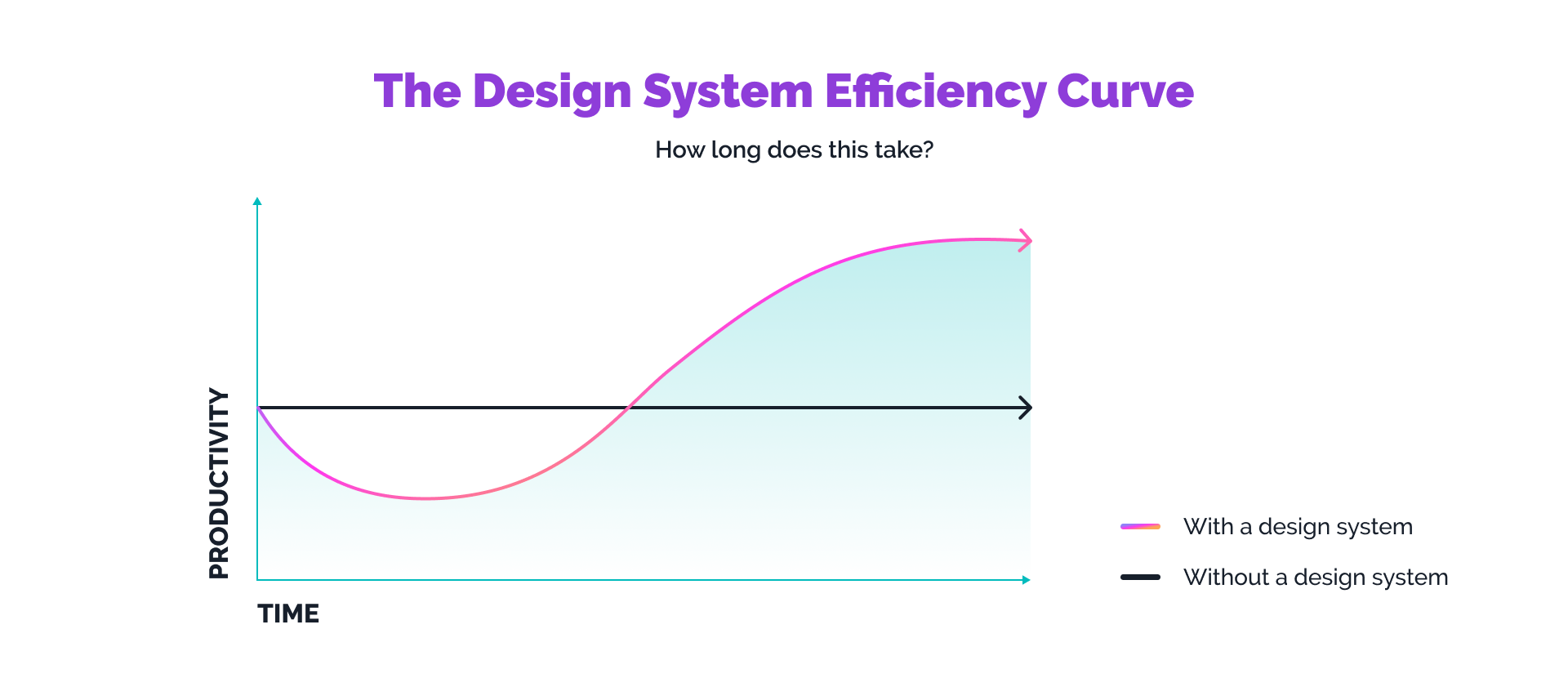
How do design systems enhance and accelerate the product development process?
Thanks to design systems, it is possible to enhance and accelerate the product development process. The design system is the source of code snippets, documents, and other digital assets that are reusable and design-established.
Work on the product can take less time, and thanks to pre-tested components, you can focus on further development rather than on generally available basics. This significantly increases productivity. Developers and designers can focus on iterations and deployment of new features.
Developers can take care of the dynamic development of the product and increase its consistency and availability for the end user. The design system can also be developed in a way that takes into account the WCAG guidelines. In times when the product life cycle is shorter, the ability to automate and use components in different versions allows you to keep up with changes and quickly implement new solutions.10
How does a design system contribute to creating a consistent user experience?
The components that are available in the design system are pre-tested, or they are built based on an already existing, implemented solution. However, it is impossible to determine the usefulness of a given component reliably. Whether they are understood by the user and function correctly depends on the context in which they are used. When a certain variant becomes common in many solutions, the user develops certain habits. He expects a particular component to perform a function he already knows. Therefore, they are known to increase a consistent user experience because they become visually friendly and identifiable.
Also, combining them together is not a problem. It is also common to create components that are developed in several variants – each variant for a different device. Thanks to this, they will be displayed differently on devices with a desktop resolution than on mobile RWD running on a computer. The variant developed for mobile resolution displayed on the phone with the use of the device recognition function will look even different.
The individual elements work together, thanks to which the final product is responsive and responds to the needs and expectations of users on different devices and operating systems. The aforementioned visual consistency significantly supports UX design. Users can use features that are visually consistent throughout the application or website.
The design system makes it possible to create a coherent image of the brand and its products that function in the same way, and the product structure is visually recognizable across all screens for each user.11
Can consistency in user experience impact customer satisfaction and retention?
Definitely, consistency can have a big impact on whether current users will be satisfied with using a particular digital product or rather turn to the competition.
Products and services with coherent components increase the intuitiveness of use, build trust, and make it easier to navigate the website or use the product. Familiarity is a way to increase the simplicity of use, which allows the end user to quickly and effectively achieve the intended goal.
Consistency can therefore affect the loyalty of the user and encourage him to continue using the services or products of a given business. Therefore, it affects the overall experience and reduces cognitive load.
Nowadays, users interact with the company through many sources. These are social media, websites, web applications, software, mailing, etc. The lack of brand cohesion can be disastrous for the entire business, reduce the customer’s trust in the business and cause they will no longer identify with it.
Read also: What is project risk?
A study by Lucidpress – the impact of brand consistency on sales results
A study by Lucidpress clearly shows that consistency has a big impact on users and can increase business revenue by up to 33%. However, according to a survey conducted by McKinsey, a strong brand can increase sales and increase the likelihood of a customer buying from a given company by up to 3.5 times.12
Can a well-implemented design system influence a company’s brand reputation?
Using the solutions offered by the design system and their proper implementation can have a positive impact on the brand’s reputation. Carefully implemented components of the design system make the brand visually consistent across all sales and promotion channels. This inspires trust, enables customers to identify with the brand, and proves its reliability in the message addressed to the final customer.
A well-implemented design system is a system where attention is paid to details. The visual version represents full professionalism, responsible and serious approach to creating the presented solutions and to the user himself. It is also a business commitment to provide a high-quality experience which users appreciate and demonstrate in their loyalty to the business.
Well-used design system capabilities make the brand more recognizable, and competitive, evoke positive emotions, have positive associations and make users identify with it. Over time, they can also recommend specific products or services themselves, thanks to which they become, in a way, ambassadors of a given brand.
Case studies demonstrating the impact of design systems on business outcomes
The results of the survey directed by Sparkbox show how much the design system affects the business outcome.
Information was collected from two groups of respondents. One of them were in-house respondents representing their own experience with design systems. The second group of respondents were people representing the customer’s point of view.
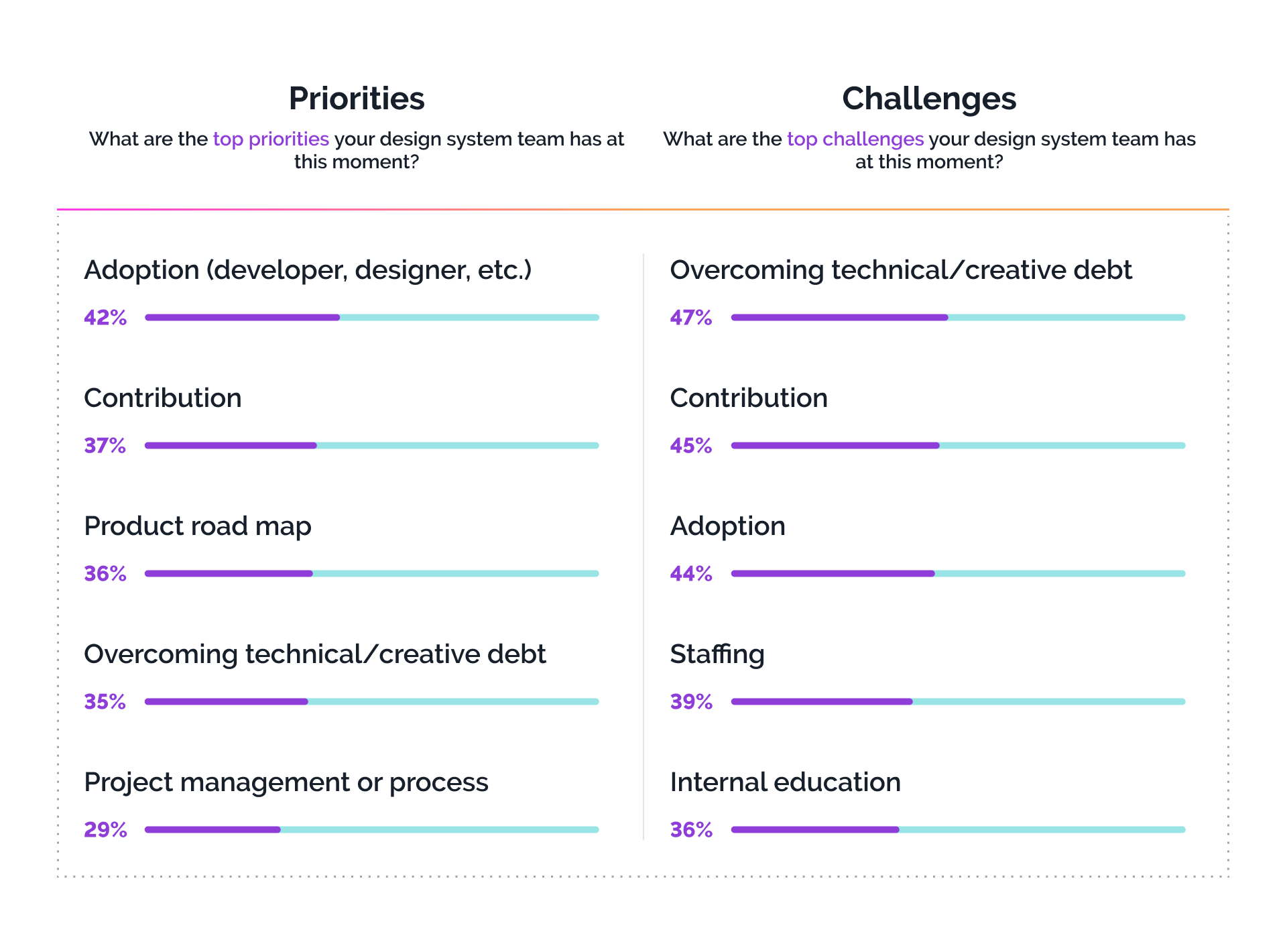
As you can see in the picture above, the biggest priorities and challenges include encouraging adoption, engaging contributors, and overcoming debt.
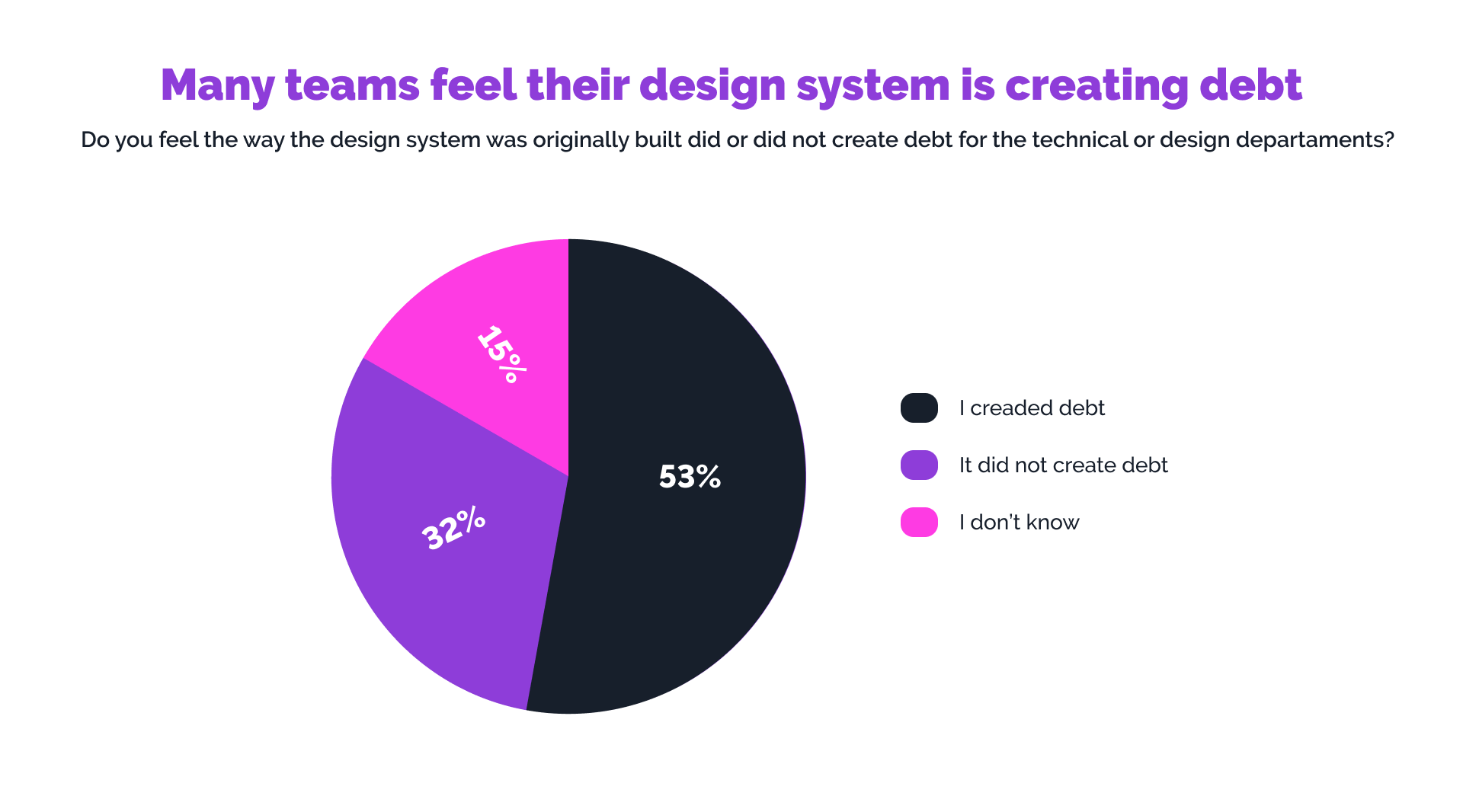
The photo above clearly shows that many teams believe that their design systems create debt.
What did the respondents consider to be the reason for debt?
- lack of complete documentation and reliable technical implementation,
- implementation of design system components when the product is already along the lifecycle,
- making changes only after the product has been released.
To sum up, in order to gain maximum benefits, it is important to convince yourself to the adoption stage and increase the involvement of employees in working on the design system.
It is also essential to track design system metrics because these data allow for a clear recognition of the correlation between the design system and business success. Then it is easier to determine that successful design systems allow businesses to benefit greatly from them. It is also significant to realize that this is only a path to success and not the only exclusive means to achieve it. But it can still be seen that design systems contribute to revenue generation and should be treated as an investment in the future of business.
How does a design system help in the long-term reduction of project and technical debt?
Using the design system is an investment that contributes to reducing project and technical debt in the long run. It is a source of established components that can be reused without having to re-develop them from scratch.
It is also a way to avoid duplicating tasks that employees have already done and reduce the likelihood of inconsistencies. The use of standard solutions provides the basis for maintaining high-quality code.
The design system enables the use of established solutions, which significantly reduce the risk of errors, and the code is manageable and easy to maintain.
The design system provides clarity and a solid foundation for understandable communication between all employees and project groups. With a design system, communication between people involved in designing an application or website will be easier and more convenient.
Thanks to a well-developed design system, you can avoid many mistakes and quickly reduce project and technical debt in a relatively short time.
How can design systems support scalability as a company grows?
The design system supports scalability for large and complex products. It is also the best solution for a business that implements long-term projects. Design system effectively supports the work of large and extensive teams.
This means that thanks to the design system, you can effectively develop a small, single product and efficaciously work on creating a multi-product offer. The centralized design system makes it easy to maintain consistency and libraries available in multiple technologies.
What are the consequences of using a design system in terms of cost savings?
When do the costs associated with creating a design system pay off and allow you to save money? This moment is the next project to work on in a particular business. A growing company collects a database of information, knowledge, and code samples that can be used in future projects. Predefined components are reusable, which saves time and money.18
Cost savings are also based on the use of established design patterns, increased design efficiency, and shorter time spent on product or service development. The design time can be significantly reduced because the low-fidelity issue can be completely omitted, thanks to the design system. In this way, you can go straight to creating projects that do not require as much work to achieve a ready-made solution. Also, the business itself receives the finished project much faster because it can familiarize itself with High-Fidelity projects much more efficiently than low-fidelity projects.
Saving time means saving money and is also determined by the minimized number of bugs that would have to be debugged. All individual elements contribute to large savings in the business and the opportunity to allocate this time and money for even more dynamic development.
How does a design system facilitate better collaboration between designers and developers?
It is not without a reason that the design system is referred to as a single source of truth.19 It makes collaboration between designers and developers more efficient. They communicate using one unified language and can rely on the components that underpin their work. They receive a unified source of information and documentation that they can implement without the need for repeated consultation about the basic aspects of the brand and the assumptions of its visual presentation.
How can a design system assist in onboarding new designers or developers into a team?
The design system is a great help for new team members. It is a source of well-documented knowledge about unified design language, guidelines, and resources. This is the basis of the work of all employees, which is used by both groups of designers and developers.
Providing new employees with access to this knowledge base will give them a chance to quickly implement and understand the basics on which a specific project or even the entire brand is based. New employees gain self-confidence and quickly adapt to the expectations of the brand.
After they master the unified language, they can immediately propose the development of existing solutions and participate in effective collaboration between teammates. What is important, new developers and designers can always return to the design system and use it as a fundamental source in their work.
What is the role of design systems in reducing errors and inconsistencies in the final product?
Considering that the components included in the design system are well-tested and proven, using them greatly reduces the number of errors made. Placing these components in the design system means that they are based on established design principles. Applied as recommended, they will not cause errors.
When do errors occur? The problem arises when decisions about a given component are made ad-hoc or components from the design system are not used at all in the developed projects.
No need to develop basic solutions from scratch also results in better code quality, its readability, and finally greater consistency of products developed for a given brand.
How can a design system help in maintaining overall product quality?
The great advantage of the design system is that it is treated as a centralized repository for all employees, in particular, designers and developers.
However, the quality of the product itself is based on consistency and offering the final customer a flawless solution. Reusable components and best practices make it easier to maintain dynamic product development at the highest level while taking into account a better user experience.
How can design systems help align business goals with user needs?
Design systems is not a way to align business goals with user needs. It’s just a middle ground, a collection of proven design fundamentals and code snippets that have worked for previous projects and helped them succeed.
Their targeted development can have a very positive impact on business goals. It can also facilitate the direction of change and development that focuses on the needs of the user. Therefore, it will be a means to create user-friendly products that will enable the fulfilment of business goals.
How does the iterative improvement of a design system contribute to continuous improvement in business outcomes?
The design system is a product itself. It should not be treated as a finished tool, but a living project that requires improvement and work on it. That is why it is so important that the components and the knowledge gathered about them are updated, tested, and adjusted.
The graphic below shows what the iteration process should look like.
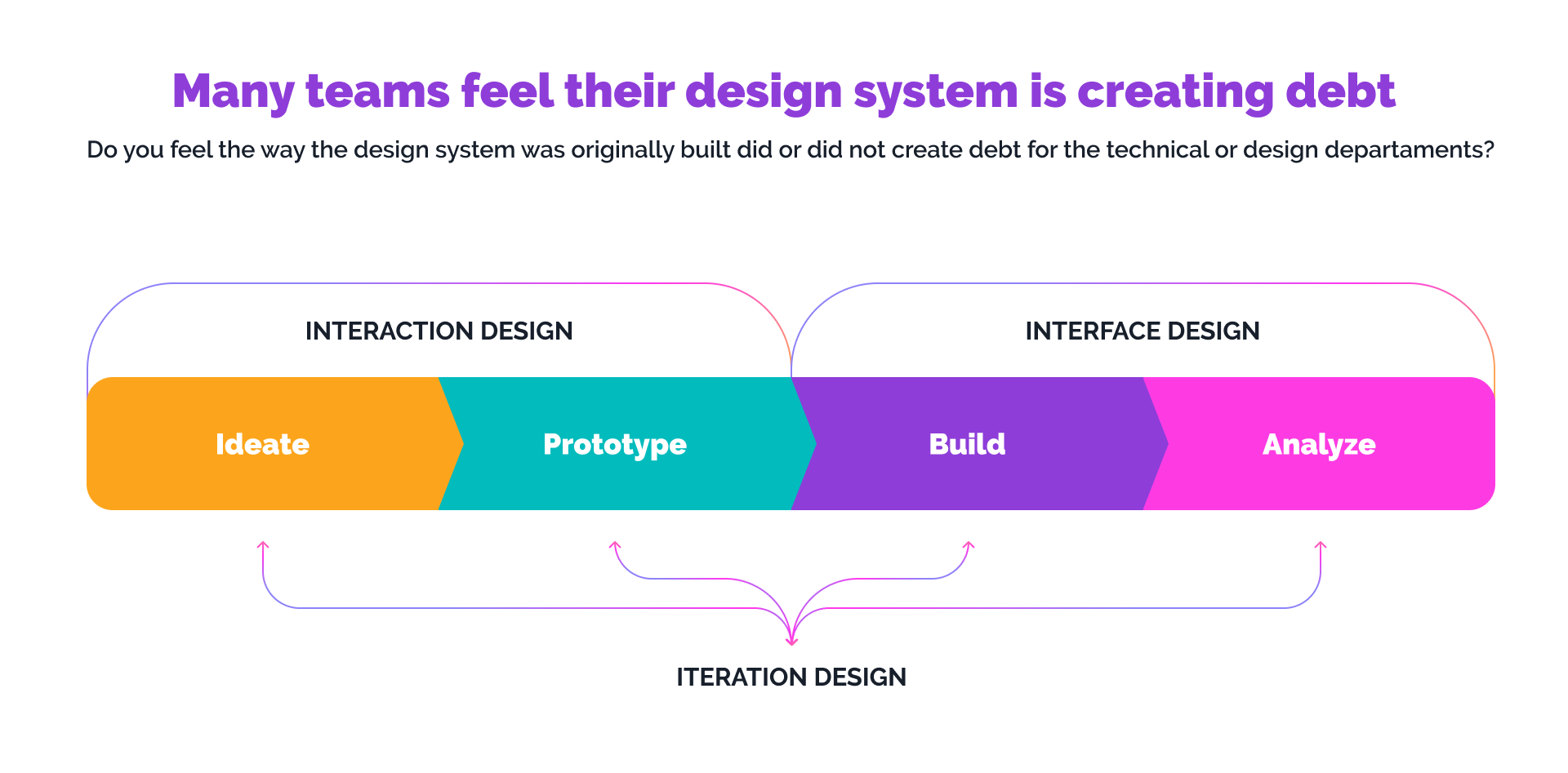
Changes in the design system should take place along with the evolution of the product. It is necessary to take into account the changing user needs and user feedback, technological advancement while not forgetting about creating user-friendly products, consistency essential for the brand and achieving business goals. Continuing iterative improvement and maintenance is inevitable and essential for business development.
What are the challenges companies may face during the implementation of a design system, and how can they be overcome?
Many companies believe that they should decide to introduce a design system. However, there are many obstacles that block businesses from initiating change. We are talking here about difficulties with adoption, technical debt, and maintaining consistency while the company still uses different technologies. However, changes may proceed step by step:
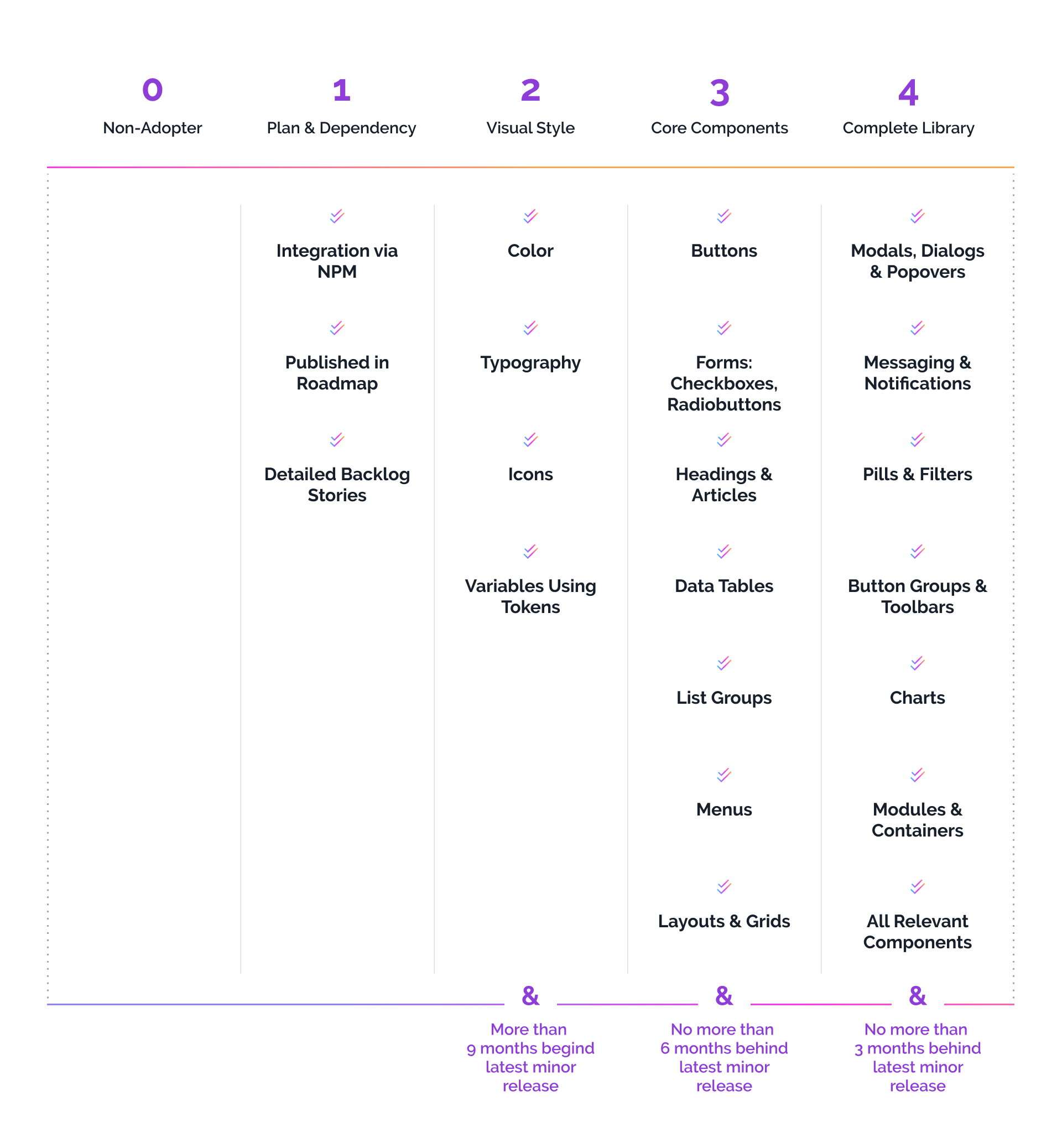
How to deal with the changes and the challenge, which is undoubtedly the introduction of the design system?
Adoption can be approached progressively. Work on the implementation of the design system should be based on providing employees with appropriate documentation that will enable the development of the system. Throughout the entire process, there must be constant support, training, and clear communication between all business representatives who work for its development. These are stakeholders, designers, and developers.
It is important that each stage of change clearly defines what it concerns and what its deadline is. To avoid the feeling of being overwhelmed, it is worth discussing the individual stages with the participants of the changes.
It is also significant to remember that every existing product may have its limitations. Some of them will only partially adapt to the changes and implement the design system.
What does the future of design systems look like, and how can they impact business outcomes?
The constant development of the design system is the key to keeping it up-to-date and beneficial to achieving business goals. Considering that modern and advanced technologies are already used in these systems, it is only a matter of time before automation, and AI will take part in their management and development.
Thanks to automation and AI algorithms, adaptation to changes will be more efficient and faster, with less emphasis on employees’ personal involvement.
Contrary to appearances, an evolutionary, not a revolutionary, approach to change can bring many positive effects for business, including increased productivity, improved business scaling, and faster iterations.
Are you looking for a professional business partner who can help you with creating a design system for your company? You’re in the right place! Just drop us a line, and we’ll take care of the rest.
